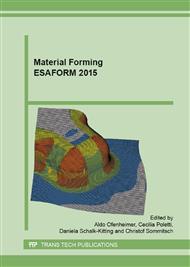p.144
p.150
p.156
p.163
p.169
p.175
p.181
p.187
p.193
A Comparative Study of the Identification Methods for Tube Hydroforming Process
Abstract:
The present paper aims to assess the accuracy of identification methods used in the evaluation of the flow stress relationship of tubular materials for hydroforming applications. Based on experimental data acquired from home designed and manufactured experimental tool and results collected from literature, flow stress parameters are determined using both analytical and inverse identification methods. The obtained results are coped to experimental measurements to validate the proposed approaches. It is shown from the analysis based on the comparative assessment of flow stress inferred from tube bulge test that, inverse parameter identification method is the appropriate methodology that contribute to a more accurate tube hydroforming characterization.
Info:
Periodical:
Pages:
169-174
Citation:
Online since:
July 2015
Authors:
Price:
Сopyright:
© 2015 Trans Tech Publications Ltd. All Rights Reserved
Share:
Citation:


